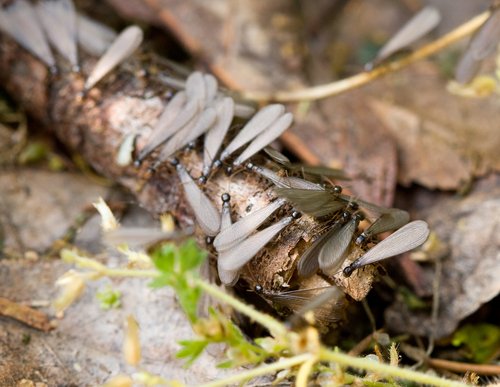As a Houston resident, you’re likely familiar with termites as a destructive pest. You or someone you know may even have history with the wood-devouring insect already. Often times, termites go unnoticed, and the first sign of damage is the tip of the iceberg. However, beginning in April, termites become a much more visible problem by gathering in large, flying groups known as swarms. This year, we are already beginning to notice termite swarming taking place!
So, if undetected termites can cause untold destruction, should you worry about home damage if you see a swarming termite colony? Continue reading to learn this along with other characteristics of swarming termites.
Also read: 3 Reasons Termites Can Go Undetected
What is a Swarm of Termites?
Termites are small, beige insects that live in large colonies, known for feeding on wood. These insects come in three castes, or class – workers, soldiers, and alates. Alates are termites that have developed wings. When you hear “termite swarms”, this means a swarm of alates specifically.
But what exactly is a termite swarm? A swarm is a colony of termites – anywhere from one to three million – that looks like a moving, dark brown cloud. These swarms happen when alates, the winged caste, reach reproductive maturity. Because of their wings, swarming termites can be mistaken for flying ants. To differentiate swarming termites from flying ants, look for these characteristics of termites:
- Straight antennae that look like a collection of tiny beads
- Broad waist
- Wings that are equal in length and longer than the body of the termite
Also read: Termites Swarming: Facts You Need To Know
Why Do Termites Swarm?
As mentioned, termite swarms happen when termites reach maturity. Once they reach this reproductive milestone, they leave their original nest in huge groups to look for suitable mates to create their own colonies. The end goal of any swarm is to increase the overall termite population.
While all termites swarm for the same reason, It’s interesting to note different species of termites swarm during different parts of the day. Most breeds of subterranean termites generally swarm in the day, while Formosan termites swarm at night. No matter the breed, termites do not fly well and rely on the wind for help. Due to this, swarms don’t last long and don’t stray too far from their original nests.
Are Swarming Termites Dangerous?
Termites, in general, can potentially bite and sting you, but the wounds are not toxic. Swarming termites will not purposefully harm you, because their primary goal is to find a new colony. Before swarming, they can cause structural damage to the area where they originated.
What Does Termite Damage Look Like?
Termite damage is similar in appearance to water damage. Signs of termite damage include crumbling wood and swollen floors and ceilings. Another indicator of termite damage are cracks in wood veneer, small mud tubes, and shed insect wings (termites lose their wings after they’ve mated).
It’s important to seek out professional help if you find any signs of termites, because your floors, walls, and ceilings could potentially collapse from long-term damage.
What to Do About Swarming Termites
If you see any of the above indications of swarming termites, or in a place prone to termites (dry, warm climates), and do not want to risk extensive damage, contact a professional pest control company like Cypress Creek Pest Control to inspect your home. Experts can conduct a thorough inspection and recommend the best solutions for your situation. Once identified, a treatment plan depending on the type of termite will be developed.
Also read: What You Should Know About A Professional Termite Inspection
How To Prevent Future Swarms
After treating your termite problem with a professional, you should take action to safeguard your home from any future termite swarms. Here are some recommended tips:
- Consistent monitoring of your home, especially wooden decks, fences, and other wooden objects
- Fixing leaky pipes or broken downspouts
- Not storing piles of wood near your home
- Ventilating and different humid environments
- Removing any tree stumps from your property
- Keeping any wooden parts of your foundation six to 18 inches above the soil
- Undergoing a termite inspection at least once a year
Although termite damage can cause potential deep damage, termite treatments are efficient and effective when done by experienced termite extermination professionals. Cypress Creek Pest Control offers that experience and professionalism, along with a termite warranty that ensures our methods work. If you see a termite swarm, contact us to schedule a termite extermination service.



